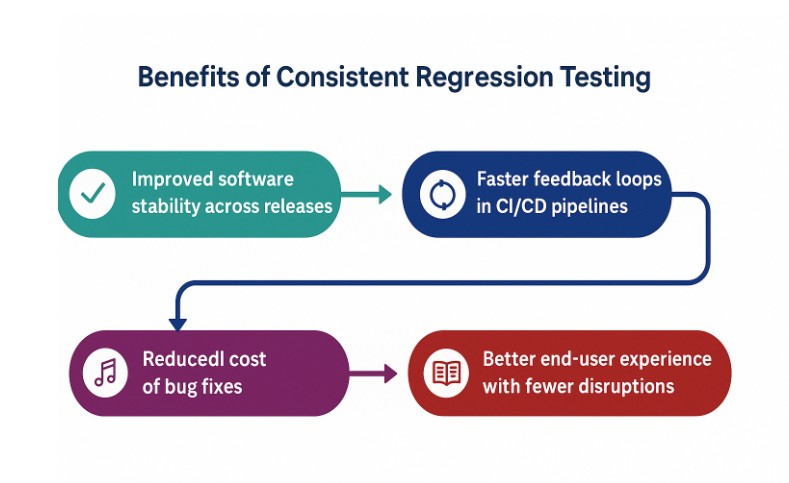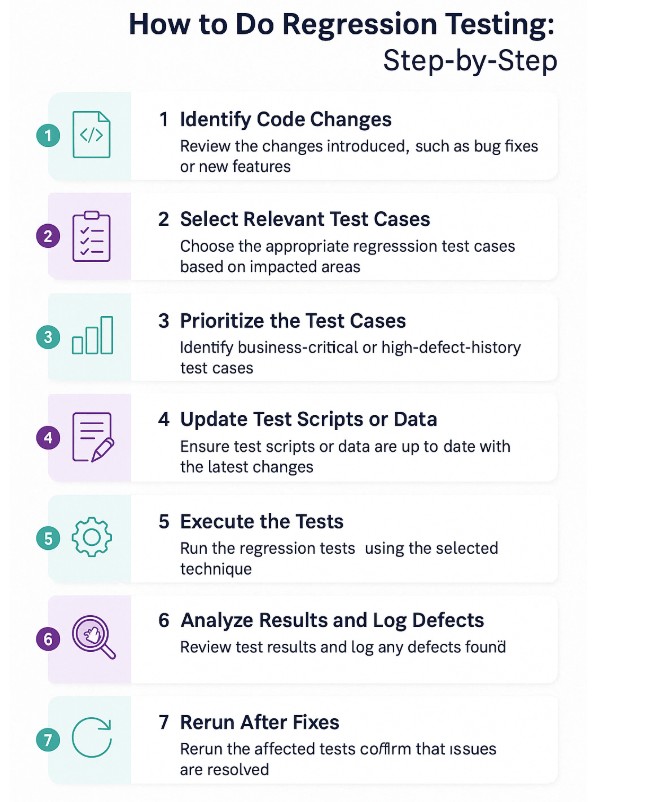What is Regression Testing? A Complete Guide for 2025
You pushed a hotfix. All tests passed. But somehow, the login flow just broke.
No one touched that module but now it’s throwing 500s in prod and support is blowing up Slack.
Sound familiar? This is the nightmare scenario every developer and tester dreads: hidden breakages caused by recent changes that weren’t caught early enough.
In fact, a recent Stack Overflow Developer Survey shows that over 60% of developers push code to production multiple times a week- sometimes even daily. In high-velocity environments like these, undetected regressions aren’t just probable, they’re inevitable without the right testing strategy. This is why a good regression testing process is very critical.
In this guide, we’ll break down exactly how regression testing helps you catch these silent failures- before your users do. We’ll cover the what, why, and how including techniques, types, and tools that modern QA and Dev teams swear by.
What is Regression Testing in Software Testing?
Regression testing is a way to check if your code still works right despite the recent changes. There are instances where performance improvements can disrupt other parts that were working fine before. This is where regression testing plays a pivotal role by spotting such issues in software testing.
Here's what it does:
-
Checks that fixed bugs stay fixed
-
Makes sure old features still work after adding new ones
-
Helps find problems early, before users do
You can do regression testing manually, but many teams use automation tools to run these tests quickly.
Example: Let’s say your team adds a new payment method to your app. Without regression testing, a small conflict in the payment logic might accidentally break the existing credit card checkout flow even if you never touched that part of the code.
Regression testing is a critical step in the post-integration phase of the SDLC. It’s especially crucial in environments where:
-
Code is continuously integrated and deployed (CI/CD)
-
Teams follow Agile or DevOps methodologies
-
Multiple developers contribute to the same codebase
Regression Testing vs Retesting
These two terms are often confused, but they serve different purposes:
| Aspect | Regression Testing | Retesting |
|---|---|---|
| Purpose | To check that unchanged features still work | To verify that a specific bug has been fixed |
| Scope | Broader – across modules | Narrow – focused on a particular defect |
| Test cases | Pre-existing test suite | New or targeted test cases for one issue |
| Timing | After code changes are merged | After a defect has been marked as fixed |
In short regression testing prevents new problems, while retesting confirms a known problem is resolved. Read More: To understand how regression testing fits into broader testing strategies, check out this comparison of manual vs automation testing.
Tired of chasing bugs after every release?
Try DevAssure—our intelligent regression testing automation helps you catch issues before they hit production.
🚀 See how DevAssure accelerates test automation, improves coverage, and reduces QA effort.
Schedule a customized demo with our team today.
Why is Regression Testing Important?
In fast-moving development environments, change is constant and so is the risk of breakage. Every new feature, bug fix, or backend optimization introduces the potential for regressions: bugs that affect previously working functionality. That’s why regression testing is essential.
It acts as a safeguard that ensures your core application logic remains intact even as new code is added. By systematically re-testing previously validated components, regression testing helps teams detect unexpected issues early in the development cycle.
Without regression testing, you risk:
-
Silent failures going unnoticed until production
-
Broken user flows that impact conversion and engagement
-
Release rollbacks due to unstable builds
-
Decreased developer confidence in shipping updates quickly
Benefits of Consistent Regression Testing

-
Improved software stability across releases
-
Faster feedback loops in CI/CD pipelines
-
Reduced cost of bug fixes, as issues are caught earlier
-
Better end-user experience with fewer disruptions
Types of Regression Testing
Depending on the scope of changes and the level of risk, regression testing can be applied in several ways. Below are the most common types:
| Type | What It Does | When to Use | Example |
|---|---|---|---|
| Unit Regression Testing | Tests individual units or components in isolation. | Small, isolated code changes during early development. | Refactoring a login validation function and testing it independently before integration. |
| Partial Regression Testing | Tests the changed module and directly dependent modules. | Code changes that impact a feature and its closely connected components. | Updating pricing logic in a cart and testing it along with the order summary. |
| Complete Regression Testing | Validates the entire application end-to-end. | Before major releases or large-scale system upgrades. | Running all test suites before launching a new SaaS version. |
| Progressive Regression Testing | Ensures new test cases don’t interfere with existing functionality. | Agile sprints where new features are added regularly. | Adding a reporting dashboard and testing new features with existing navigation. |
| Selective Regression Testing | Runs only the impacted subset of test cases using automation. | CI/CD pipelines or time-constrained testing cycles. | An automation tool runs 30 impacted tests out of a 300-case suite after a UI change. |
Curious about visual regression testing? Explore our complete guide to key tools, techniques, and learn how to perform it effectively using DevAssure.
When Should You Do Regression Testing?
Regression testing should be performed anytime code changes could impact existing functionality- directly or indirectly. It’s not about when you want to test, but when you must to avoid breakage, poor UX, or production failures.
Below are the most common and critical moments to trigger regression tests:
- After Bug Fixes
Even minor fixes can cause new issues elsewhere. Regression tests ensure the fix didn’t accidentally break something unrelated.
- After Adding New Features
New code often touches shared components or services. Regression testing checks whether other functionality is still intact.
- After Code Refactoring
Refactors aim to improve internal code structure without changing functionality—but regression testing ensures that remains true.
- After Integrating Third-Party Services or APIs
External dependencies can behave unpredictably or clash with internal logic. Regression testing confirms that integration hasn't caused side effects.
- Before Major Releases or Deployments
A full regression test suite acts as a safety net before releasing new builds—especially those with multiple updates across the system.
- During CI/CD Pipeline Executions
Automated regression testing is often baked into CI/CD workflows to run with every code merge or deployment. This ensures continuous quality at speed.
Regression Testing Techniques
Below are the most widely used techniques in both manual and automated regression testing workflows.

- Retest All
Execute every test case in the regression suite- regardless of the scope of the code change. While this provides maximum test coverage, it’s the most time- and resource-intensive method. Best used before major releases or in safety-critical applications.
- Regression Test Selection
Only a subset of the test suite is executed—typically the ones impacted by recent code changes. Test cases are often categorized as reusable or obsolete based on their relevance in upcoming cycles. This approach is faster and more scalable than retest all.
- Test Case Prioritization
Test cases are ranked and executed based on priority—typically by business criticality, user frequency, or historical defect density. High-priority test cases are executed first to catch the most impactful regressions early.
- Hybrid Approach
Combines both test selection and prioritization. Only the most relevant and high-priority test cases are selected and executed. This technique is ideal for CI/CD pipelines where speed, relevance, and risk balance are key.
Manual vs Automated Regression Testing
Regression testing can be executed either manually or through automation. Both approaches have their place depending on the nature of the application, release frequency, and available resources.
Here’s how they compare:
Manual vs Automated Regression Testing
| Criteria | Manual Regression Testing | Automated Regression Testing |
|---|---|---|
| Definition | Test cases are executed manually by a QA engineer without the help of automation tools | Test scripts are run automatically using testing frameworks or tools |
| Speed | Slower execution; time-consuming | Fast execution; ideal for frequent testing cycles |
| Scalability | Difficult to scale as the number of test cases grows | Easily scalable across large test suites and multiple environments |
| Accuracy | Subject to human error and inconsistency | Highly reliable and consistent across executions |
| Maintenance | No script maintenance needed, but repetitive effort required | Requires ongoing maintenance of test scripts and automation infrastructure |
| Best Use Cases | Early-stage projects, visual/UX validations, exploratory testing | Stable applications, large regression suites, continuous integration pipelines |
| Cost Efficiency | More expensive over time due to manual effort | Higher initial investment but lower long-term execution cost |
Tools like DevAssure make it easier to set up and manage automated regression tests without needing to write a ton of code or deal with complicated setups. If you're just getting started, check out our automation testing guide for a solid foundation.
How to Do Regression Testing: Step-by-Step
Below is a step-by-step approach that works for both manual and automated testing workflows.

- Identify Code Changes
Begin by reviewing the changes that are introduced that may include bug fixes, new features, enhancements, or refactoring.
- Select Relevant Test Cases
Based on the impacted areas, select the appropriate regression test cases. If you’re using test automation, this step can be accelerated using test impact analysis tools or tagging strategies.
- Prioritize the Test Cases
Not all test cases are created equal. Identify which ones are business-critical, have a high defect history, or support user-critical flows.
- Update Test Scripts or Data
Before running tests, ensure that your scripts (for automation) or manual test steps are updated to reflect the latest changes. Outdated scripts can lead to false positives or missed bugs.
- Execute the Tests
Run the regression tests using the selected technique—retest all, test selection, or hybrid. In automated environments, this may be triggered as part of your CI/CD pipeline.
- Analyze Results and Log Defects
Review the test execution results and log any failures. Collaborate with developers to triage and fix regressions promptly.
- Rerun After Fixes
Once bugs are resolved, rerun the affected regression test cases to ensure the issues are fixed and haven’t triggered further regressions.
Best Practices for Regression Testing
Running regression tests is one thing but doing it efficiently is another. Here are some best practices to doing regression tests in the most reliable manner:
- Maintain a Dedicated Regression Test Cases
Create and continuously refine a separate suite of test cases specifically for regression. This makes it easier to run quick checks and isolate failures related to new code changes.
Tip: Use tagging or folder structures in your test management tool to separate regression cases from others.
- Automate Repetitive and Critical Test Cases
Automating your regression test cases saves a lot of time and prevents manual errors. Focus on automating stable, frequently used, and business-critical features.
Tip: Integrate automation into your CI/CD pipeline to trigger tests automatically on every code commit or merge.
- Use Version Control to Track Test Case Relevance
As your application evolves, your test cases should evolve too. Keep your test documentation and scripts version-controlled to avoid outdated or obsolete tests being included in future runs.
Tip: Archive or flag test cases that no longer apply to avoid noise in test reporting.
- Prioritize Test Cases Based on Risk and Impact
Not all test cases need to be run every time. Use business priorities, historical defect data, and module dependencies to decide what’s most important for each cycle.
Tip: Use a risk-based testing matrix or impact analysis tools to drive decisions.
- Leverage Parallel Execution
To save time, run tests across different environments or browsers simultaneously especially if you’re working with a large test suite and short sprint cycles.
Tip: Many automation tools like DevAssure support this.
- Regularly Review and Refactor the Test Suite
As your product grows, some of the test cases might become redundant or ineffective. Ensure regular checks and audits are conducted to remove outdated, or duplicated cases.
Tip: Schedule a monthly test case hygiene session as part of your QA workflow.
- Monitor and Analyze Test Metrics
Track and analyze test metrics like execution time, failure rate etc. and leverage these insights to improve your testing process and product quality.
Tip: Use dashboards or test analytics tools to identify trends and bottlenecks.
Challenges in Regression Testing
While we understand the importance of regression testing it comes with its own set of challenges:
-
Time constraints: Running large regression suites can be time-consuming, especially without automation.
-
Complexity: As your application evolves, the number of test cases increases which makes it hard to manage.
-
Regular Maintenance: Test cases must be updated frequently to stay relevant. Changes in features or workflows make older test cases unreliable or outdated.
-
Lack of Visibility: Without proper reporting or analytics, teams are clueless on understanding what needs to be done.
Top Regression Testing Tools
1. DevAssure

DevAssure is a unified AI-driven low-code test automation platform designed for modern QA teams. It supports end-to-end regression testing across web, mobile, and APIs ensuring high-quality software delivery.
It offers:
-
Visual regression testing capabilities
-
Smart test case selection using impact analysis
-
Parallel execution for faster feedback cycles
-
CI/CD integration with platforms like GitHub, Jenkins, and GitLab
-
Intuitive interface for both technical and non-technical users
DevAssure uses smart AI tools to make regression testing much faster. This means you can deliver better products without long delays. It works smoothly with your regular development process and lets you test while you build, making it perfect for teams who need to work fast!
2. Selenium

Selenium is an open-source tool for automating browser-based apps. It supports a number of languages, including C#, Python, and Java. It works well with programs like JUnit and TestNG.
Despite its strength and adaptability, Selenium can be resource-intensive to scale and maintain for large regression suites and requires skilled developers.
3. BrowserStack

BrowserStack is a cloud-based cross-browser testing platform that enables teams to perform both automated and manual testing on more than 3,000 real devices and browsers. Without requiring device labs or local infrastructure, it facilitates regression testing on both mobile and web platforms.
BrowserStack helps accelerate regression cycles while guaranteeing wide device and browser coverage with features like parallel execution, automated Selenium test runs, Percy (for visual regression testing), and real-time debugging tools.
4. Testsigma

Designed as a cloud-based no-code test automation tool, Testsigma streamlines regression testing across desktop, mobile, APIs, and web applications. It is accessible for non-technical users while still being strong for QA engineers since teams may create automated tests in plain English.
In fast-paced development environments, the platform supports real-time execution, parallel testing, test data management, and seamless CI/CD integrations, enabling quick turnarounds.
5. Appium

Appium is a flexible open-source automation tool built for mobile apps-native, hybrid, and mobile web. It supports several programming languages and lets cross-platform testing out of one codebase.
It is best suited for teams concentrated on mobile app testing across iOS and Android.
6. Playwright

Playwright is a contemporary automation tool with a single API for testing Chromium, Firefox, and WebKit. It supports cross-border automation, multi-tab interactions, and headless and headful testing.
It is good for developers seeking fast, dependable control over browser behavior during regression testing.
7. TestComplete

TestComplete by SmartBear is a powerful commercial tool for UI and functional testing. It supports script-based and keyword-driven test creation, with record-and-playback features for faster test development.
It’s particularly useful for teams testing across web, mobile, and desktop apps, and looking for an all-in-one commercial solution with enterprise support.
How to Choose the Right Regression Testing Tool
The best regression testing tool isn't always the most feature-rich, it should be one that fits naturally into your workflow and enhances efficiency. Here’s what to consider while choosing the right regression tool.
-
Ease of use: Choose tools that are easy to use. Low-code platforms are great for team collaboration.
-
Application coverage: The tool should support your tech stack be it- web, mobile, API, or desktop.
-
Speed and integration: Look for tools that are capable of accelerating the testing process.
-
Maintenance: The tests should be updated after the code changes. Ensure that the tool makes it easy to update and maintain your tests..
-
Technical support: Ensure that your platform has proper technical support in place to address technical queries.
How DevAssure Simplifies Regression Testing
Regression testing doesn’t have to be time consuming and complex. Tools like DevAssure help automate regression testing without writing extensive code. It automatically identifies the impacted test cases using intelligent test selection and offers an intuitive, low code interface that empowers both testers and developers.
DevAssure enables visual regression testing to catch UI-level changes with precision and supports parallel test execution for faster feedback cycles
Whether you're dealing with weekly releases, multiple environments, or complex workflows, DevAssure reduces test maintenance and boosts coverage so your team can release with confidence.
🚀 See how DevAssure accelerates test automation, improves coverage, and reduces QA effort.
Schedule a customized demo with our team today.
